Our regular viewer on the remote cameras from England, Pam Birley sent this set of images she had taken today on camera 1 of a Sea Otter at Race Rocks.
Click the sea otter tag below for other observations of sea otters here.

Our regular viewer on the remote cameras from England, Pam Birley sent this set of images she had taken today on camera 1 of a Sea Otter at Race Rocks.
Click the sea otter tag below for other observations of sea otters here.
Divers at Race Rocks often see this species standing out with its bright blue colouration when underwater. Exposed above water, it looses the bright blue colour, and has a rather drab reddish colour.
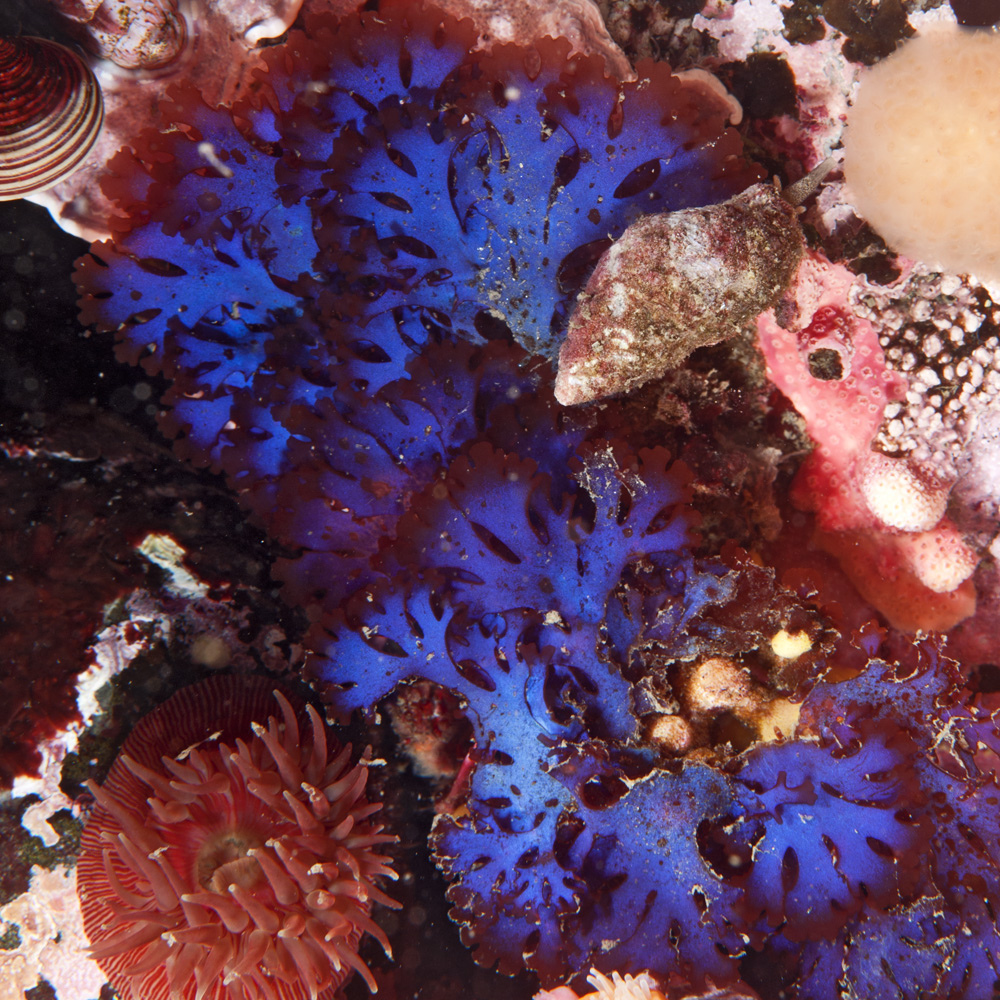
Fauchea laciniata photo by Ryan Murphy
See other photos by Ryan Murphy on this Flickr site.
Other Members of the Phylum Rhodophyta at Race Rock
and Image File |
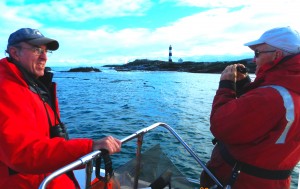 We want to thank Lester Pearson College for providing transportation to the Race Rocks Ecological Reserve for the 2014 Christmas Bird Count. Ecoguardian Alex Fletcher picked up Garry Fletcher and Val George with the Race Rocks boat from the Pearson College docks at 9:30 AM. We were able to do a Pedder Bay count as well.
We want to thank Lester Pearson College for providing transportation to the Race Rocks Ecological Reserve for the 2014 Christmas Bird Count. Ecoguardian Alex Fletcher picked up Garry Fletcher and Val George with the Race Rocks boat from the Pearson College docks at 9:30 AM. We were able to do a Pedder Bay count as well.
The following is the spreadsheet for the 2014 Christmas Bird Count prepared by Val and Garry. Link to the Index for the past Race Rocks records for the Christmas Bird Counts
2014 Christmas Bird Count –
Summary for Race Rocks and Race Passage
I went to Race Rocks today with Val George for the Christmas bird Count. ( See other reports from today.) The highlight of course was the discovery of the first record for the Boreal Owl in Southern Vancouver Island . Some other observations from my visit are included here:
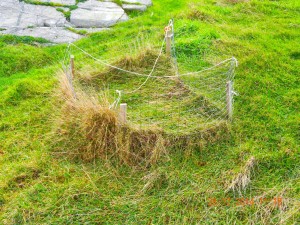 |
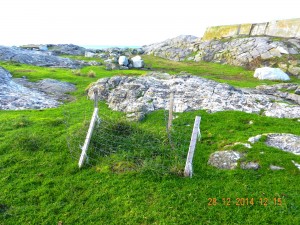 |
| Several 1 metre exclosures for goose grazing have been installed on the grass areas on Race Rocks. | Winter grazing by the Canada geese (introduced to Vancouver Island in the 1980s) has resulted in erosion in some areas of the island, and grass turf cover is prevented. |
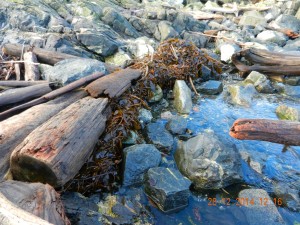 |
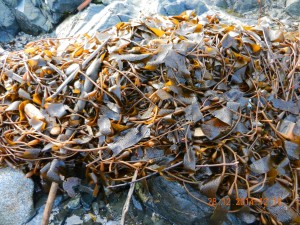 |
| Drift Macrocystis at the jetty. This Giant Kelp can grow anchored at great depths but winter storms will lift it up and the main contribution to energy-flow in the ecosystem comes from decomposition on the shoreline. | Macrocystis grows in areas of high salinity, so not in he brackish estuarine conditions of the Strait of Juan de Fuca , but not at Race Rocks where it ends up only as drift in the strand line. |
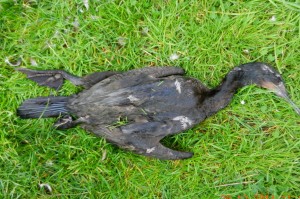 |
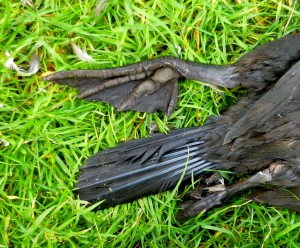 |
| A dead cormorant, (probably Brandt’s ). | Interesting webbed foot structure. |
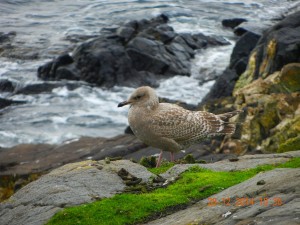 |
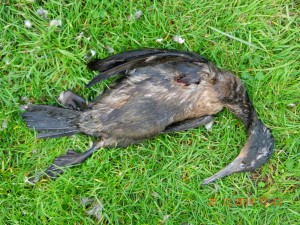 |
| A 1st year juvenile Thayer’s Gull | The breast had a hole and internal organs were eaten. It was probably from an eagle attack. |
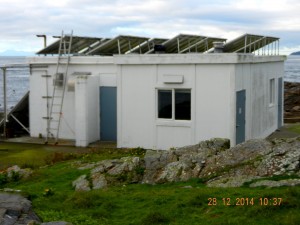 |
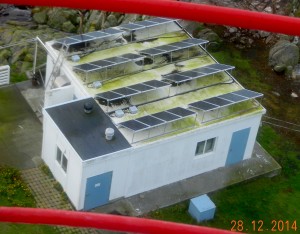 |
| This year, the college has finished tilting the solar panels. Increased energy efficiency has been noted. They were originally installed flat since we were concerned that the strength of the wind may damage them. This hasn’t happened. | View of the energy building roof from the top of the tower. |
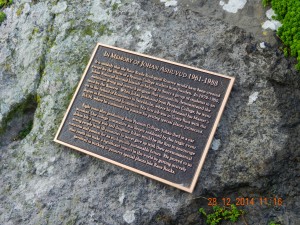 |
.. |
| This fall a plaque has been installed to honour Johan Ashuvud, who as a student at Pearson College, was instrumental in having Race Rocks designated as an ecological reserve in 1980 | .. |
Other Ecological reserves wardens reports are available here:

Boreal Owl (Aegolius funereus): for measurement –the pipe is 5 cm (2 inch) diameter–photo by Alex Fletcher, Ecoguardian at Race Rocks, Dec 28, 2014.
December 28, 2014– Val George and myself were picked up at Pedder Bay By Alex Fletcher, (Ecoguardian at Race Rocks) and we went out to Race Rocks for the Sooke area Christmas Bird Count. It was a great day with many high counts , but we were especially surprized to flush a small owl out from under a rock up near the camera 5 pedestal. At first Val thought it just could be a Boreal owl (Aegolius funereus) which would be a first for this area. We found it again under the porch of the Ecoguardians house and were able to get some good pictures of it. Then we decided it must be a Saw whet owl as Boreals are just too rare here. When he returned home and started comparing his pictures with other images, Val realized it was indeed the rare ( for this area) Boreal owl.
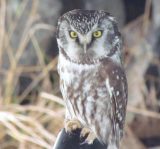 Report in Times Colonist : Newcomer thrills watchers at Sooke Christmas Bird Count
Report in Times Colonist : Newcomer thrills watchers at Sooke Christmas Bird Count
(These owls breed in dense coniferous forests across northern North America and Eurasia and in mountain ranges such as the Alps and the Rockies. The subspecies: A.f. richardsoni is the only one that occurs in North America). It lays 3–6 eggs in a tree hole in the forest. The small nocturnal owl eats mainly voles and other mammals but also birds as well as insects and other invertebrates.)--text in brackets adapted from Wikipedia–
Scientific classification
Kingdom: Animalia
Phylum: Chordata
Class: Aves
Order: Strigiformes
Family: Strigidae
Genus: Aegolius
Species: A. funereus
Aegolius funereus (Linnaeus, 1758)
Subspecies: A.f. richardsoni (Bonaparte, 1838)
Other owls photographed at Race Rocks.
Link to the call of the Boreal Owl:
From the reference: Rare Birds of Vancouver Island: Compiled by Rick Toochin, Paul Levesque and Jamie Fenneman July1, 2013: The following notation indicates only three other records of the Boreal Owl on Vancouver Island, but there are no records for it on southern Vancouver island.
Boreal Owl (Aegolius funereus):
1.(1) adult February 27, 1993: fide Don Cecile (specimen) Tofino (Siddle 1993b)
2.(1) adult October 3, 1994: Marc Winfield, Rick Toochin, Mike Toochin: Triangle Island (Toochin 1995) (Bowling 1995a)
3.(1) adult fall 1996: fide Jamie Fenneman (specimen) Courtenay (Bain and Holder 1996f)
and Image File |
 The Race Rocks taxonomy is a collaborative venture originally started with the Biology and Environmental Systems students of Lester Pearson College UWC. It now also has contributions added by Faculty, Staff, Volunteers and Observers on the remote control webcams. The Race Rocks taxonomy is a collaborative venture originally started with the Biology and Environmental Systems students of Lester Pearson College UWC. It now also has contributions added by Faculty, Staff, Volunteers and Observers on the remote control webcams.Garry Fletcher, Dec. 2014. |
Note on banded cormorant:
The bird (KC0) was banded as an adult at a breeding colony on East Sand Island in the Columbia River estuary (near Astoria, OR) in May 2013 by the group, Bird Research Northwest (http://www.birdresearchnw.org
http://news.
On Dec . 30, 2014 the following details were sent to us after we reported it to the
The North American Bird Banding Program
Banding Data returned after reporting:
Band Number :1128-01387 KC0
Species: Double-Crested Cormorant
Age of Bird : Hatched in 2011 or earlier
Banded : 05/31/2013 Sex Unknown
Location: East Sand Island, 2.4 KM West-Southwest of Chinook, WA, Clatsop county , Oregon USA (Coordinates: LAT: 46.25833; LON: -123.975 )
Bander Dr. Daniel D. Roby Oregon Cooperative WRU Oregon State University 104 Nasgh Hall Corvallis OR 97331 3803
Encounter Data
Location 2 mi SSE of Rocky Point, British Columbia, Canada
Encountered 12/13/2014
Desc: Race Rocks Ecological Reserve
————————————————————————————
Info from : BandReports@usgs.gov
U.S. Geological Survey
Canadian Wildlife Service
Please Report Bands at www.reportband.gov or call 1-800-327-BAND
Direct reporting form we used can be found at:
https://www.pwrc.usgs.gov/BBL/
Link to other posts on this website about Killdeers
| Domain | Eukarya |
| Kingdom | Animalia |
| Phylum | Chordata |
| Sub-Phylum | Vertebrata |
| Class | Aves |
| Order | Charadriiformes |
| Family | Charadriidae |
| Subfamily | Charadriinae |
| Genus | Charadrius |
| Species | vociferus |
| Common Name: | Killdeer |
Other Members of the Class Aves at Race Rocks.
and Image File |
 The Race Rocks taxonomy is a collaborative venture originally started with the Biology and Environmental Systems students of Lester Pearson College UWC. It now also has contributions added by Faculty, Staff, Volunteers and Observers on the remote control webcams. The Race Rocks taxonomy is a collaborative venture originally started with the Biology and Environmental Systems students of Lester Pearson College UWC. It now also has contributions added by Faculty, Staff, Volunteers and Observers on the remote control webcams.
|

Raisa Mirza in the fall of 2010 took this image of an American Pipit at Race Rocks.
8 individuals of this species were recorded on the VNHS Field Trip, Sept 27 2014.
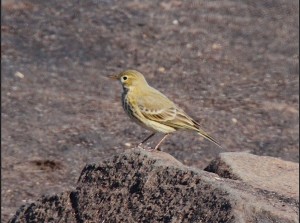
Photo of American Pipit by Daniel;e Donecke on the VNHS FIeld Trip, Sept 2014
| Scientific classification | |
|---|---|
| Kingdom: | Animalia |
| Phylum: | Chordata |
| Class: | Aves |
| Order: | Passeriformes |
| Family: | Motacillidae |
| Genus: | Anthus |
| Species: | A. rubescens |
Other Members of the Class Aves at Race Rocks.
and Image File |
 The Race Rocks taxonomy is a collaborative venture originally started with the Biology and Environmental Systems students of Lester Pearson College UWC. It now also has contributions added by Faculty, Staff, Volunteers and Observers on the remote control webcams. The Race Rocks taxonomy is a collaborative venture originally started with the Biology and Environmental Systems students of Lester Pearson College UWC. It now also has contributions added by Faculty, Staff, Volunteers and Observers on the remote control webcams. |
Oct 30, 2012 –Garry Fletcher
Today Chris Blondeau,. and Courtney Edwards took Martin Haulena , and Joe Gaydos to Race Rocks to meet with Ecoguardian Anne Stewart and take stock of the facility and make plans for how to deal with the plastic neck bands that we have are observing with the onset of the large numbers of sealions each year.
Martin is the Head Veterinarian at the Vancouver Aquarium, Joe is with Sea Doc Society in the San Juans and with U.C. Davis , California.
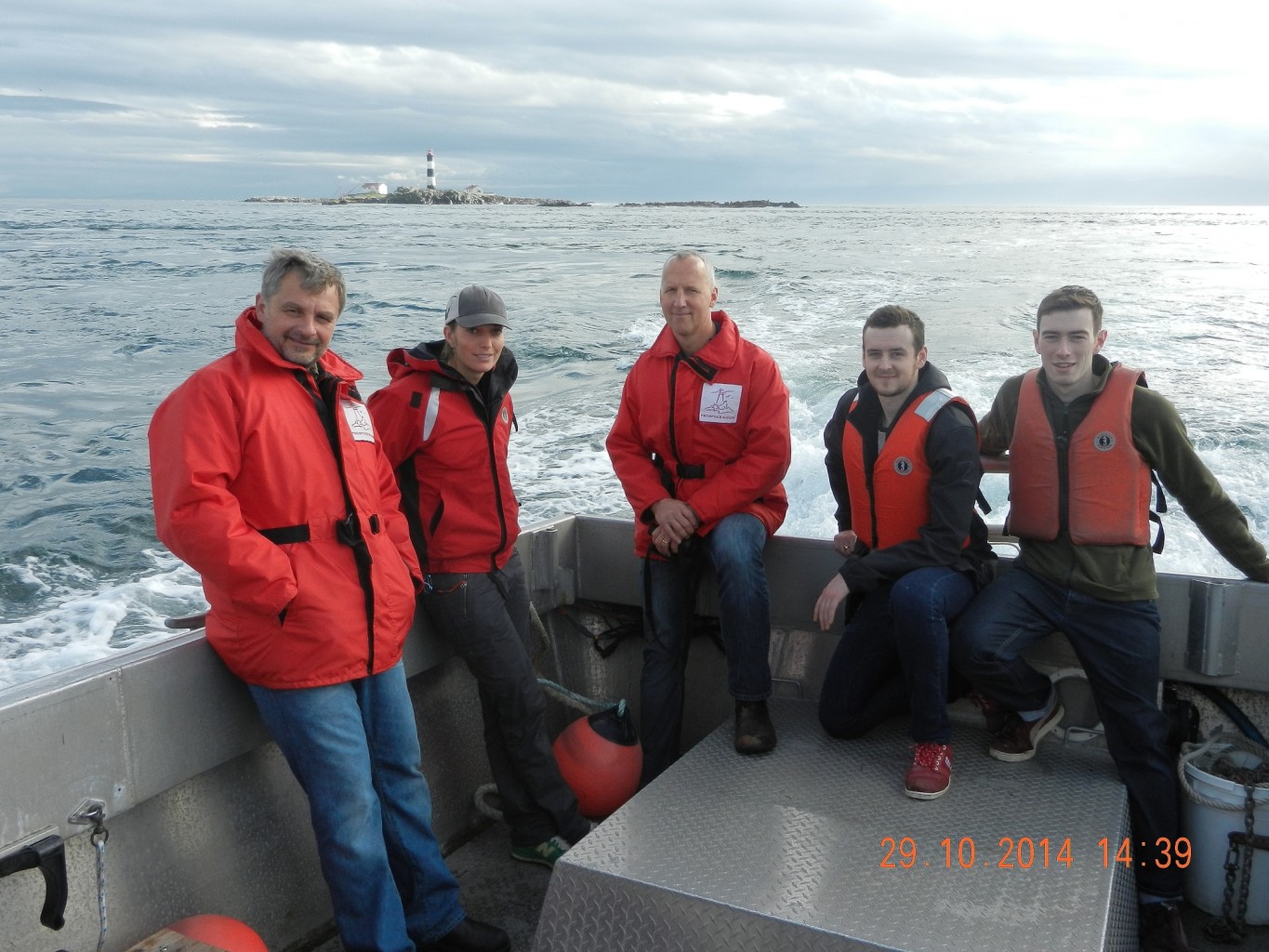
Martin, Courtney, John, former PC student from Wales and friend who are volunteering this term at the college.
Pam Birley from England just sent this great image which she took this afternoon on underwater camera 2.
Link to other observations by visitors on the webcam by clicking on the Webcam Visitor observations link in the line below.